| dc.description.abstract | Purpose
To determine causes of variability in communicable disease prevalence rates among students in secondary schools to inform policy formulation in the public health sector.
Methods
A representative cluster sample size for students was estimated using Fisher et al.’s formula while schools, sub-counties and education zones were clustered and sample size was calculated based on coefficient of variation by school type. Data were collected by questionnaire, medical examination using standard procedures, and focus group discussion, and descriptive analysis was performed on the completed questions. Comparisons between risk factors were made by chi-square and ANOVA analysis using SPSS for Windows (version 15.2; Chicago, IL) software. A p value of < 0.05 was considered statistically significant.
Results
There was significant variation between communicable disease prevalence rates and age (X2 4, 0.05 = 2.458), school size (X2 12, 0.05 = 18.636), gender (X2 4, 0.05 = 5.723) and class of students (X2 12, 0.05 = 15.202), and bed and desk spacing (p < 0.05 at 95% CI). However, there was no significant association in prevalence rates between both locality and type of school. There was strong evidence that student age has an effect on prevalence rates. The prevalence rate of malaria was higher in male (14.02%) than female students (6.68%) compared to prevalence of diarrhea, which was higher in female (7.96%) than male students.
Conclusion
This study has revealed that the prevalences of diarrhea, tuberculosis, pneumonia and other respiratory tract infections are lower among female secondary school students than males and that the prevalence of malaria is higher in males than females. Age of secondary school students is a significant vulnerability factor for malaria, diarrhea, tuberculosis and pneumonia, which were the important communicable diseases most prevalent among secondary school students in Kisumu County, Kenya. | en_US |

